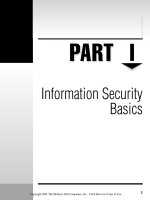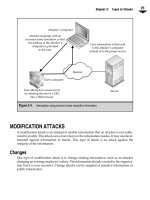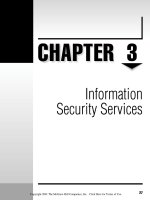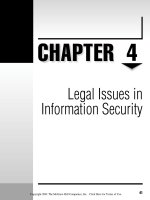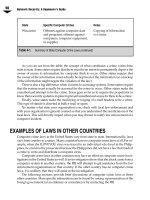Bảo mật hệ thống mạng part 7 pps
Bạn đang xem bản rút gọn của tài liệu. Xem và tải ngay bản đầy đủ của tài liệu tại đây (123.26 KB, 5 trang )
CHAPTER
4
Legal Issues in
Information Security
41
Copyright 2001 The McGraw-Hill Companies, Inc. Click Here for Terms of Use.
T
here are many legal issues with regard to information security. The most obvious
issue is that breaking into computers is against the law—well, most of the time it is.
Depending on where you are in the world, the definition of a computer crime dif
-
fers as does the punishment for engaging in such activity. No matter how the activity is
defined, if the perpetrators of the crime are to be punished, information security profes
-
sionals must understand how to gather the information necessary to assist law enforce
-
ment in the capture and prosecution of the individuals responsible.
However, computer crime is not the only issue that must be dealt with by information
security professionals. There are also the civil issues of liability and privacy that must be
examined. Organizations must understand their risks with regard to employees and
other organizations on the network if internal security is lax. New laws are being passed
that address customer and medical privacy. Violations of these laws may pose a signifi
-
cant risk to an organization, including criminal penalties. All of these issues must be
understood and examined by information security professionals in conjunction with the
legal advisors of the organization.
NOTE:
I am not an attorney and this chapter is not meant to be legal advice. The purpose of this chap-
ter is to highlight some of the legal issues surrounding information security. Legal issues may and do
change over time and thus it is best to consult your organization’s general counsel on all legal issues.
U.S. CRIMINAL LAW
The United States criminal law forms the basis for computer crime investigations by fed-
eral authorities (mainly the FBI and the Secret Service). While 18 US Code 1030 is the pri-
mary computer crime statute, other statutes may form the basis for an investigation. The
following sections discuss the statutes that are most often used. For the applicability of
these statutes to a particular situation or organization, please consult your organization’s
general counsel.
Computer Fraud and Abuse (18 US Code 1030)
As I mentioned, 18 US Code 1030 forms the basis for federal intervention in computer
crimes. There are a few things about the statute that should be understood by security
professionals, beginning with the types of computer crime that are covered by the statute.
Section (a) of the statute defines the crime as the intentional access of a computer
without authorization to do so. A second part of the statute adds that the individual
accessing the computer has to obtain information that should be protected. Close reading
of this statute gives the impression that only the computers of the U.S. government or
financial institutions are covered. However, later in the text, “protected computers” is
defined to include computers used by financial institutions, the U.S. government, or any
computer used in interstate or foreign commerce or communication.
42
Network Security: A Beginner’s Guide
Based on this definition, most of the computers connected to the Internet will qualify
as they may be used in interstate or foreign commerce or communication. One other
important point must be made about 18 US Code 1030: there is a minimum damage that
must occur before this statute may be used. The damage amount is $5,000 but this may
include the costs of investigating and correcting anything done by the individual who
gains unauthorized access. It should also be noted that the definition of damage does not
include any impairment to the confidentiality of data even though Section (a) does dis
-
cuss disclosure of information that is supposed to be protected by the government.
This statute then does not specifically prohibit gaining access to a computer if the dam
-
age that is done does not exceed $5,000. Other activity that is commonly performed by
intruders may not be illegal. For example, it was recently ruled in Georgia (see Moulton v.
VC3, N.D. Ga., Civil Action File No. 1:00-CV-434-TWT, 11/7/00) that scanning a system
did not cause damage and thus could not be punished under federal or Georgia state law.
Credit Card Fraud (18 US Code 1029)
Many computer crimes involve the stealing of credit card numbers. In this case, 18 US
Code 1029 can be used to charge the individual with a federal crime. The statute makes it
a crime to possess 15 or more counterfeit credit cards.
An attack on a computer system that allows the intruder to gain access to a large num-
ber of credit card numbers to which he does not have authorized access is a violation of
this statute. The attack will be a violation even if the attack itself did not cause $5,000 in
damage (as specified in 18 US Code 1030) if the attacker gains access to 15 or more credit
card numbers.
Copyrights (18 US Code 2319)
18 US Code 2319 defines the criminal punishments for copyright violations where an
individual is found to be reproducing or distributing copyrighted material where at least
ten copies have been made of one or more works and the total retail value of the copies
exceeds $1,000 ($2,500 for harsher penalties). If a computer system has been compro
-
mised and used as a distribution point for copyrighted software, the individual who is
providing the software for distribution is likely in violation of this statute. Again, this
is regardless of whether the cost of the compromise exceeded $5,000.
It should be noted, however, that the victim of this crime is not the owner of the sys
-
tem that was compromised but the holder of the copyright.
Interception (18 US Code 2511)
18 US Code 2511 is the wire tap statute. This statute outlaws the interception of telephone
calls and other types of electronic communication and prevents law enforcement from
using wire taps without a warrant.
An intruder into a computer system that places a “sniffer” on the system is likely to be
in violation of this statute, however.
Chapter 4: Legal Issues in Information Security
43
A reading of this statute may also indicate that certain types of monitoring performed
by organizations may be illegal. For example, if an organization places monitoring equip
-
ment on its network to examine electronic mail or to watch for attempted intrusions, does
this constitute a violation of this statute? Further reading in this statute shows that there
is an exception for the provider of the communication service. Since the organization is
the provider of the service, any employee of the organization can monitor communica
-
tion in the normal course of his or her job for the “protection of the rights or property of
the provider of that service.” This means that if it is appropriate for the organization to
monitor its own networks and computer systems to protect them, that action is allowed
under this law.
Access to Electronic Information (18 US Code 2701)
18 US Code 2701 prohibits unlawful access to stored communications but it also prohibits
preventing authorized users from accessing systems that store electronic communications.
This statute also has exceptions for the owner of the service so that the provider of the ser
-
vice may access any file on the system. This means that if an organization is providing the
communications service, any file on the system can be accessed by the organization.
Other Criminal Statutes
When a crime occurs through the use of a computer, violations of computer crime laws
are not the only statutes that can be used to charge the perpetrator. Other laws such as
mail and wire fraud can and are also used. Keep in mind as well that a computer may be
used to commit a crime totally unrelated to computer crimes. The computer or the infor-
mation stored on it may constitute evidence in the case or the case may be investigated
using computers as a means to the end.
44
Network Security: A Beginner’s Guide
Child Pornography
Many computer crime cases involve child pornography. This may be due to the way
the Internet allows such material to be circulated. Whatever the reason, since the use
of the Internet has allowed child pornography to expand and reach new audiences,
law enforcement is actively involved in tracking such individuals across the Internet.
If computers belonging to an organization are being used to store or examine
child pornography, the organization itself may suffer harm as a result. This may
range from bad publicity to confiscation of the organization’s equipment by law
enforcement. This may include any system on which the individual in question
was able to store files or print images. While this activity by law enforcement is not
supposed to inappropriately impact business, if the organization knew about the
activity and did nothing about it, additional systems may be confiscated or the
organization may be shut down.
STATE LAWS
In addition to federal computer crime statutes, many states have also developed their
own computer crime laws (see Figure 4-1). These laws differ from the federal laws with
regard to what constitutes a crime (many do not have any minimum damage amount)
and how the crime may be punished. Depending on where the crime occurred, local law
enforcement may have more interest in the case than the federal authorities. Be sure to
speak with your local law enforcement organization to understand their interest in and
their capabilities to investigate computer crime.
Table 4-1 provides a summary of the state laws. Keep in mind that state laws may
change frequently and computer crime is an area of continued research and develop
-
ment. If you have specific questions about a particular statute, consult your organiza
-
tion’s general counsel or local law enforcement.
Chapter 4: Legal Issues in Information Security
45
Figure 4-1.
U.S. states with computer crime laws
